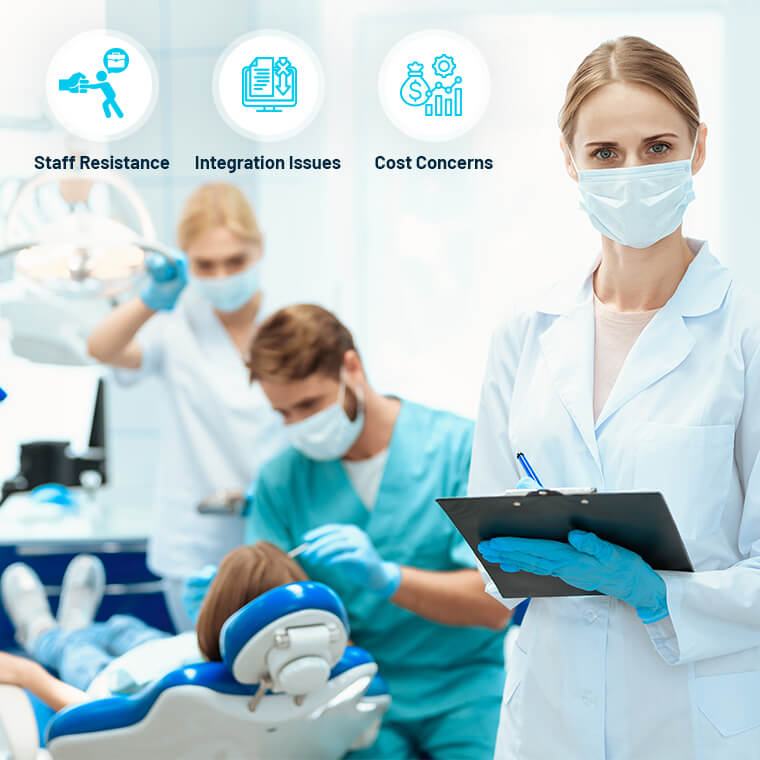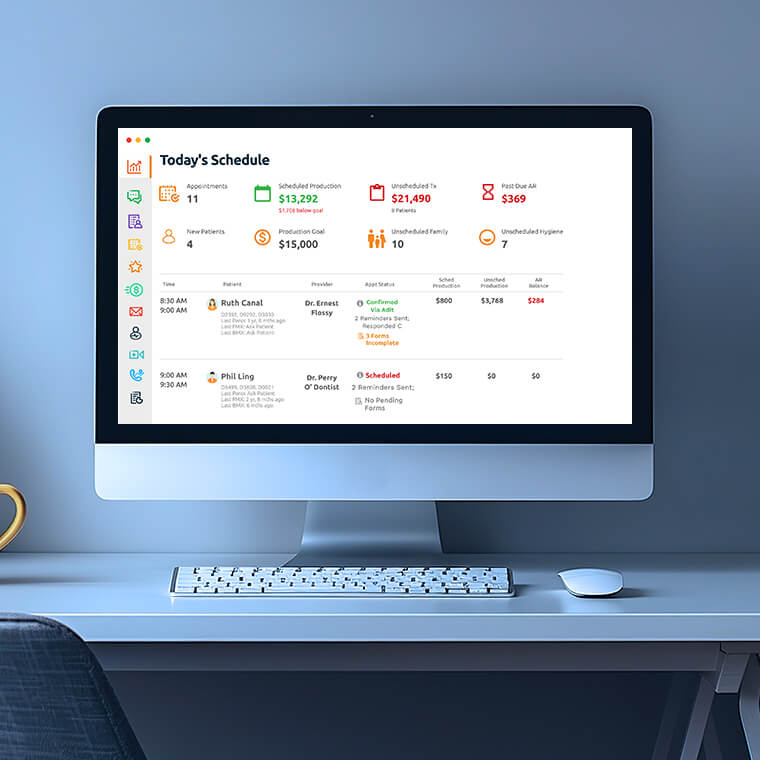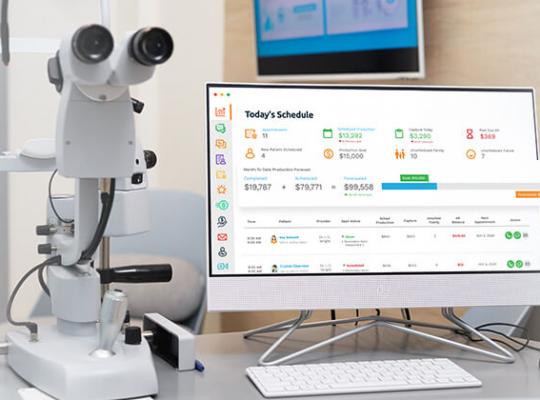Ends in
ends in 110 Days

ends in 110 Days

ends 11 July
From Mundane to Memorable: Enhancing Routine Dental Visits

Routine dental visits are essential for maintaining oral health, but they often fall into the realm of the mundane, eliciting little excitement from patients. However, the advent of advanced practice management tools offers a unique opportunity to transform these routine visits into memorable experiences.
With crucial dental technology such as treatment planning software, in-house financing options, and integrations with financial lenders like CareCredit, dental practices can elevate patient satisfaction and foster loyalty.
The New Gold Standard: Patient-Centric Dental Care

The dental industry has evolved significantly with the shift from paper-based systems to digital solutions. This transition has streamlined administrative tasks, improved patient record-keeping, and enhanced treatment planning accuracy. Key advancements include:
- Digital Records and EHRs: Electronic Health Records (EHRs) provide seamless access to comprehensive patient histories, reducing costly errors associated with manual data entry and leading to better treatment outcomes.
- Advanced Practice Management Software: These tools enable detailed, personalized treatment planning and visualization, which improves patient engagement and satisfaction.
- Financial Flexibility: Flexible payment options, including in-house financing and integration with financial services like CareCredit, help make treatments more accessible and reduce financial barriers for patients.
- Enhanced Communication: Modern practice management tools facilitate better communication between dental teams and patients, ensuring a clear understanding of treatment plans and financial arrangements, all while HIPPA compliant.
- Improved Workflow Efficiency: Digital solutions streamline administrative tasks, reducing time spent on paperwork and allowing staff to focus more on patient care.
- Data Security: Advanced dental software ensures the secure storage and management of patient information, maintaining privacy and compliance is within regulations.
These innovations have pioneered patient-centric care strategies, enhancing patient experiences, meeting evolving expectations, and addressing financial concerns effectively, leading to increased satisfaction and practice growth.
The Importance of a Seamless Patient Experience
Creating a seamless patient experience is essential for fostering satisfaction and encouraging patients to return for future visits. A smooth and efficient experience helps to build trust, reduce anxiety, and enhance overall satisfaction. By focusing on every touchpoint in the patient journey—from scheduling and reminders to check-in and treatment—dental practices can ensure that patients feel valued and well-cared-for.
Streamlining processes and minimizing friction throughout the patient’s visit not only improves operational efficiency but also makes the experience more pleasant and convenient for patients. A well-integrated system that supports these aspects can transform routine visits into positive, memorable interactions, ultimately contributing to patient loyalty and practice growth.
Ways to Make the Patient Experience Seamless:
- Online Scheduling: Allow patients to book appointments at their convenience, reducing wait times and improving accessibility.
- Automated Reminders: Use automated notifications to keep patients informed about upcoming appointments and reduce no-shows.
- Digital Check-In: Implement digital check-in options to streamline the check-in process and minimize wait times in the office.
- Clear Communication: Maintain open and transparent communication throughout the patient's visit to keep them informed and comfortable.
- Efficient Workflow: Optimize office processes and staff coordination to ensure that patient interactions are smooth and uninterrupted.
- Personalized Care: Tailor the patient experience to individual needs and preferences, making them feel valued and understood.
Focusing on these elements can enhance the overall patient experience, leading to greater satisfaction and loyalty to your dental brand.
Using Treatment Planning Software to Enhance Patient Visits

Advanced treatment planning software offers enhanced diagnostic accuracy, enabling precise treatment planning. Let’s delve into the benefits of advanced diagnostic tools, such as 3D imaging and digital radiography, and more to better understand how they contribute to better patient outcomes.
Enhanced Diagnostic Accuracy
Advanced diagnostic tools, such as 3D imaging and digital radiography, offer detailed and accurate representations of a patient’s oral health. These technologies enable dentists to identify issues with greater precision and plan treatments more effectively. The result is more accurate diagnoses and better-targeted treatment plans that address specific needs.
Comprehensive Treatment Plans
Creating comprehensive, personalized treatment plans is crucial for delivering high-quality care. Treatment planning software allows dentists to develop detailed, individualized plans that patients can easily understand. By integrating visual aids, such as digital models or imaging, these tools help patients grasp their conditions and treatment options better.
A clear visual representation of the treatment plan fosters greater patient understanding and engagement, leading to higher acceptance rates.
Patient Education
Effective patient education is essential for informed decision-making. Advanced treatment planning software facilitates this by providing visual aids and simulations that make complex concepts easier to understand. Digital models and 3D simulations allow patients to visualize their oral health issues and the proposed solutions, helping them feel more confident in their care choices.
One dental practice’s 5-year journey after replacing 3 software programs with Adit What does 5 years of success with Adit look like? For one Connecticut-based dental practice, it means smoother communication, faster...
Schedule a DemoClear communication and educational tools empower patients to make informed decisions about their treatment.
Improved Treatment Outcomes
Using advanced software to simulate different treatment scenarios and outcomes allows dentists to fine-tune their approach. This ability to predict and plan ensures that patients receive the most effective treatments tailored to their unique needs. With these simulations, dentists can explore various strategies and choose the one that offers the best results.
Streamlined Workflow Integration
Integrating treatment planning software with other practice management tools enhances workflow efficiency. By synchronizing patient data, appointment schedules, and treatment plans, dental practices can streamline their operations. This integration reduces administrative tasks, minimizes errors, and allows dental teams to focus more on patient care.
By leveraging these advanced tools, dental practices can offer a higher level of personalized, effective care that meets the needs of their patients and enhances their overall experience.
In-House Financing Options

Offering in-house financing options can lead to higher acceptance rates for recommended treatments. Curious how flexible payment plans can make dental care more affordable and encourage patients to comply with recommended treatment? Let’s look at a few tips for implementing in-house financing effectively.
Improved Cash Flow
In-house financing can provide a steady revenue stream, enhancing the financial stability of the practice. This chapter discusses the financial benefits of offering in-house financing and provides strategies for managing in-house financing programs. It also highlights the importance of clear communication with patients about financing options.
With in-house financing, dental practices can maintain a consistent cash flow by allowing patients to pay for services over time. This financial flexibility not only benefits patients but also ensures that the practice remains financially stable, enabling it to invest in new technologies and services.
Patient Loyalty
Providing financial solutions can build trust and loyalty, as patients appreciate the practice’s efforts to accommodate their needs. This chapter explores how offering in-house financing can foster patient loyalty and improve retention rates. It also provides tips for building strong relationships with patients through financial flexibility.
When patients feel that their financial concerns are being addressed, they are more likely to return for future treatments and recommend the practice to others. This loyalty translates into a stable patient base, which is crucial for long-term success.
Integrating with Financial Lenders like CareCredit

Integrating with established financial lenders like CareCredit can expand the financial options available to patients. The benefits of financing features like Adit’s CareCredit integration go beyond just making dental care more accessible, but also increases brand loyalty and trust.
Ease of Use
Integration with practice management software allows for seamless processing of CareCredit applications and payments. A tech-forward integration with financial lenders simplifies the application process for patients, reducing the time and effort required to secure financing.
Patient Trust
Partnering with a reputable financial lender like CareCredit can boost patient confidence in the practice’s commitment to affordability. Patients are more likely to trust a dental practice that offers reliable financial solutions from well-known lenders. By clearly communicating the financial availability and benefits of such resources, practices can reassure patients that their financial well-being is a top priority.
Transforming Routine Visits into Memorable Experiences

If your practice is facing challenges with patient retention and satisfaction due to long wait times and limited financial options, it may be time to go paperless. Or, maybe your dental office is focusing on improving patient engagement and treatment acceptance. With advanced treatment planning software, your team could present detailed treatment plans with visual aids.
Whatever your current goals for your practice, successfully implementing practice management tools requires careful planning and a clear understanding of your practice’s needs. This section outlines best practices for selecting, deploying, and maximizing the benefits of these tools.
1. Assessing Needs
Identifying the specific needs and goals of your practice is crucial for selecting the right tools. This chapter provides a framework for assessing practice needs and determining which practice management tools will be most beneficial. It also discusses the importance of involving staff in the assessment process.
By thoroughly evaluating the unique challenges and opportunities within your practice, you can select tools that align with your objectives and patient demographics. Involving your team in this process ensures that everyone is on board and that the chosen tools will address the practical needs of the practice.
2. Choosing the Right Tools
Selecting practice management software and financial solutions that align with your practice’s requirements and patient demographics is essential. When evaluating options, consider how well the tools integrate with your existing systems, their ease of use, and the level of customer support provided. Additionally, patient feedback can offer valuable insights into the tools' effectiveness and usability, helping to ensure that the selected solutions meet both practice and patient needs.
3. Staff Training
Providing comprehensive training for your staff is critical to ensure they are proficient in using the new tools. Effective training programs should include hands-on sessions, conferences and seminars, clear documentation, and access to ongoing support. Regular refresher courses and updates on new features can help staff stay current with the tools and maintain a high level of proficiency. Well-trained staff are essential for leveraging the full potential of practice management tools and ensuring a smooth transition to new systems.
4. Patient Communication
Clear communication with patients about new tools and how they will enhance their experience is essential. Transparent communication about the benefits of new tools helps patients understand how these changes will improve their care experience. Utilizing multiple channels, such as email, social media, and in-office signage, can effectively reach patients and address any questions or concerns they may have. Educating patients on how to use new features, like online scheduling or digital check-in, ensures they can take full advantage of these innovations.
The Role of Patient Feedback

Actively seeking and acting on patient feedback is a cornerstone of continuous improvement in dental care. Understanding patient needs and addressing their concerns enhances the quality of care and strengthens the patient-provider relationship. This section explores the multifaceted role of patient feedback, its analysis, and the importance of responsive action.
1. Collecting Patient Feedback
Patient feedback can be gathered through various methods, each providing unique insights into the patient experience. Effective feedback collection involves:
- Surveys: Structured surveys allow patients to provide detailed responses about their experiences. These can be administered via email, through practice management software, or on paper.
- Online Reviews: Monitoring reviews on platforms like Google and Yelp offers real-time feedback and public perceptions of the practice.
- Direct Communication: Engaging patients in conversation during visits or follow-up calls can yield immediate and candid feedback.
- Suggestion Boxes: Providing a physical or digital suggestion box encourages patients to share their thoughts anonymously.
2. Conducting the Analysis
Analyzing patient feedback is crucial for identifying strengths and areas for improvement. This process involves:
- Aggregating Responses: Collect and compile feedback from various sources to get a comprehensive view of patient sentiments.
- Identifying Common Themes: Look for recurring comments or issues that highlight common patient concerns or praises.
- Utilizing Data Analytics: Employ data analytics tools to interpret feedback trends and extract actionable insights. This helps in pinpointing specific areas that need attention and tracking changes over time.
For instance, data analytics can reveal patterns in patient complaints about wait times, suggesting the need for schedule adjustments or additional staff training.
3. Forming a Response
Responding effectively to patient feedback demonstrates a commitment to addressing concerns and improving care. Key strategies include:
- Timeliness and Thoughtfulness: Address feedback promptly and thoughtfully. Acknowledge the patient’s concerns and outline steps taken to address them.
- Implementing Changes: Use feedback as a basis for actionable improvements. Whether it’s refining office procedures, enhancing communication, or upgrading facilities, make visible changes that respond to patient needs.
- Communicating Updates: Inform patients about the changes made in response to their feedback. This not only reinforces their importance but also showcases the practice’s dedication to continuous improvement.
If feedback indicates dissatisfaction with appointment scheduling, implementing an online booking system and communicating this new feature can significantly enhance patient engagement and satisfaction.
A practice that actively seeks, analyzes, and responds to patient feedback fosters trust and loyalty. Involving patients in the improvement process builds a sense of partnership and commitment to delivering excellent care. This proactive approach not only improves patient satisfaction but also contributes to long-term practice growth and patient retention.
Future Trends in Dental Practice Management

As technology continues to advance, several key trends are reshaping the landscape of dental practice management. Staying ahead of these trends is essential for dental practices to maintain competitiveness, enhance patient care, and improve operational efficiency. This section explores emerging trends, their benefits, and practical considerations for their integration into dental practices.
1. Telehealth: Expanding Access and Convenience
Telehealth has revolutionized patient care by offering virtual consultations, which can significantly enhance patient access and convenience. This trend is especially valuable for:
- Follow-Up Appointments: Patients can easily schedule follow-up visits without needing to travel, reducing the burden on both the patient and the practice.
- Consultations for Minor Concerns: Virtual appointments can address minor issues that don’t require an in-office visit, saving time for both patients and practitioners.
2. AI and Machine Learning: Revolutionizing Diagnostics and Efficiency
Artificial Intelligence (AI) and machine learning are optimizing dental practice management by enhancing diagnostic accuracy and streamlining administrative tasks. These technologies offer:
- Enhanced Diagnostics: AI-driven tools can analyze images and data to identify patterns and anomalies that may be missed by the human eye. This leads to more accurate diagnoses and better patient outcomes.
- Optimized Treatment Plans: Machine learning algorithms can predict patient outcomes and suggest tailored treatment plans based on historical data.
3. Patient-Centric Care: Leveraging Data for Personalized Treatment
Data analytics is increasingly being used to create personalized treatment plans that enhance patient satisfaction and outcomes. This approach involves:
- Customized Care: Tailoring treatment plans to each patient’s specific needs and preferences based on data-driven insights.
- Predictive Analytics: Using data to anticipate patient needs and outcomes, allowing for more proactive and individualized care.
4. Additional Trends to Watch
In addition to the earlier mentioned trends, consider Incorporating the following into your dental practice operations to allow your team to provide high-quality, patient-centered care while improving operational efficiency:
- Streamlined Operations: The integration of digital workflows, including electronic health records (EHRs) and practice management software, enhances efficiency and reduces errors. By automating administrative tasks and improving record-keeping, practices can focus more on patient care.
- Enhanced Communication: Tools like automated appointment reminders, patient portals, and mobile apps can improve patient engagement and satisfaction. These tools facilitate better communication, streamline appointment scheduling, and provide patients with easy access to their health information.
- Eco-Friendly Solutions: Implementing sustainable practices, such as reducing paper usage and investing in energy-efficient technologies, not only benefits the environment but also enhances the practice’s reputation as a socially responsible provider.
Overcoming Challenges in Implementing Practice Management Tools

Implementing new practice management tools can present various challenges. Addressing these challenges proactively can ensure a smooth transition and successful adoption of new technologies.
1. Staff Resistance
Change can be challenging, and staff may resist new tools and processes. Overcoming this resistance requires clear communication about the benefits of the new tools, comprehensive training, and ongoing support. Involving staff in the decision-making process can also foster a sense of ownership and acceptance.
Engaging staff early in the implementation process and addressing their concerns can help ease resistance. Providing detailed explanations of how the new tools will improve their work and offering continuous support can facilitate a smoother transition and encourage staff buy-in.
2. Integration Issues
Integrating new practice management tools with existing systems can pose technical challenges. Choosing compatible software solutions and working with experienced vendors can mitigate these issues. It’s also crucial to have a phased implementation plan and provide adequate staff training.
A phased approach to integration allows for gradual adoption and minimizes disruptions to daily operations. Collaborating with experienced vendors and ensuring that new tools are compatible with existing systems can help overcome integration challenges and ensure a seamless transition.
3. Cost Concerns
The initial investment in advanced practice management tools can be significant. However, the long-term benefits, such as increased efficiency, higher patient satisfaction, and improved financial performance, often outweigh the costs.
Exploring financing options or phased implementation can help manage the financial impact of new tools. Evaluating the return on investment (ROI) and the potential long-term benefits can provide a clearer picture of the value these tools bring to the practice. Cloud-based software options like Adit often are the best option because of the low-upfront cost and quick benefit.
The Long-Term Impact of Enhanced Patient Experiences

Transforming routine dental visits into memorable experiences can have a profound impact on a dental practice. Patients who feel valued and well cared for are more likely to return for regular visits, adhere to treatment plans, and recommend the practice to others. This leads to improved patient retention, higher treatment acceptance rates, and a stronger reputation in the community.
1. Building a Loyal Patient Base
Consistently providing exceptional patient experiences builds trust and loyalty. Patients who have positive experiences are more likely to stay with the practice long-term, reducing the need for costly marketing efforts to attract new patients. Loyal patients also tend to refer friends and family, further enhancing the practice’s growth.
A loyal patient base provides stability and reduces marketing costs, as satisfied patients are more likely to refer others. Building strong relationships through exceptional care and personalized experiences is key to fostering long-term patient loyalty.
2. Enhancing Reputation
A practice known for its patient-centric approach and use of advanced technologies will stand out in a competitive market. Positive reviews and word-of-mouth recommendations can boost the practice’s reputation, attracting new patients who seek high-quality care and modern conveniences.
Positive patient experiences translate into favorable online reviews and referrals, which can significantly enhance the practice’s reputation. Leveraging advanced technologies and maintaining a patient-centric approach helps the practice stand out in a crowded market.
3. Financial Growth
By increasing treatment acceptance rates and improving patient retention, practices can achieve sustainable financial growth. The use of in-house financing and integrations with financial lenders like CareCredit also ensures a steady cash flow, enhancing the practice’s financial stability and enabling further investments in technology and staff development.
Improving financial accessibility and patient retention contributes to a stable and growing practice. The financial benefits of offering flexible payment options and leveraging advanced practice management tools support long-term growth and success.
Transform Routine Dental Visits with Adit

Routine dental visits do not have to be mundane, but transforming routine dental visits from mundane to memorable requires a strategic approach and the right tools. Enhance your dental practice today with Adit Dental Software.
Compare and Switch Today
Our comprehensive suite of tools, including advanced treatment planning and exclusive CareCredit integration, can ensure visits are stellar experiences for your patients.
- Online Scheduling: Allow patients to book appointments online, improving accessibility and convenience.
- Automated Appointment Reminders: Reduce no-shows and keep patients informed about their appointments through SMS or email reminders.
- CareCredit Integration: Enjoy next-level financing convenience with our exclusive CareCredit feature.
- Patient Forms: Streamline the check-in process, reduce wait times, and enhance the overall patient experience with automated check-in capabilities.
- Telemed: Offer virtual consultations to improve access to dental care and convenience for patients.
- Patient Text: Connect with patients conveniently via mobile with our highly scalable and responsive patient SMS features.
- Adit Voice: Centralize all of your communication channels in one place, enhancing engagement and connecting all your siloed accounts without the multiple logins.
- AI-Driven Analytics: Provide patients with the ultimate personalized dental care experience with our intuitive practice analytics tool.
- Personalized Treatment Plans: Leverage data analytics to create individualized treatment plans that improve patient outcomes and satisfaction.
- Call Tracking: Continuously improve patient interactions with your team and marketing campaigns with ease using our automated call tracking feature.
- Patient Recall Systems: Implement automated recall systems to ensure patients return for regular check-ups and follow-up treatments.
- Pozative Reviews Management: Encourage satisfied patients to leave positive reviews online, enhancing your practice's reputation and attracting new patients.
- Adit Pay: Streamline billing and payment processing with integrated solutions that simplify financial transactions.
With Adit's tech-forward dental practice management features, your office can meet and exceed patient expectations, ensuring a thriving future. Book a free demo today to see the difference Adit Dental Software can make in your office.
more about Adit?
Access a full suite of patient communication tools with Adit! Texting, payments, reviews, & scheduling in one place.
Schedule a DemoJosh has made a career working with large DSO organizations and leveraging his extensive sales experience to build partnerships with influential doctors and organizations within the dental industry. He travels the US as an expert guest speaker in medical seminars teaching doctors how to streamline their practices with the latest technology.
Get a $25 Gift Card when you take a demo
Schedule a Demo
Get a $50 Gift Card
when you take a demo
Looks like you're out of bounds!
Hey there! Your current location falls outside Adit's area of operation. If this is unexpected, try disabling your VPN and refresh your page. For further assistance or to book a live demo, connect with us at 832-225-8865.
December 21 Amazon Demo Promo
Terms and Conditions
Last Updated: December 21, 2025Offer ends December 24, 2025, and is limited to prospective customers who sign an annual agreement before December 31, 2025. Gift card will be emailed to the company owner or established representative within 4 weeks of signing the annual agreement. Offer may not be combined with any other offers and is limited to one (1) gift card per office. Offer is not available to current customers or to prospective customers or individuals that have participated in a Adit demo during the prior six (6) months. Recipient is responsible for all taxes and fees associated with receipt and/or use of the gift card as well as reporting the receipt of the gift card as required under applicable federal and state laws. Adit is not responsible for and will not replace the gift card if it is lost or damaged, is not used within any applicable timeframe, or is misused by the recipient. Adit is not responsible for any injury or damage to persons or property which may be caused, directly or indirectly, in whole or in part, from the recipient’s participation in the promotion or receipt or use of the gift card. Recipient agrees to indemnify, defend and hold harmless Adit from and against any and all claims, expenses, and liabilities (including reasonable attorney’s fees) arising out of or relating to a recipient’s participation in the promotion and/or recipient’s acceptance, use or misuse of the gift card. This offer is sponsored by Adit Communications, Inc. and is in no way sponsored, endorsed or administered by, or associated with Amazon.
Thank You!
We appreciate your interest! Adit AI will be calling you in the next few minutes!
Why Adit?
Cut your software bill by up to 60% when you merge everything your dental office needs to run under one roof.
Centralize Communications
- Phones & TeleMed
- Emails & eFax
- Texting & Reminders
- Call Tracking and more!
Streamline Operations
- Patient Forms
- Online Scheduling
- Payments
- Reviews and more!
Boost Production
- Performance Dashboards
- Morning Huddle
- Claims & Collections
- Patient Profiles
- Follow Up Lists
- Year Over Year Metrics
Acquire More Patients
- Digital Marketing
- Website Design
- SEO
- Google Ads
- Facebook Ads
Ends in

Sign up by filling out the form







